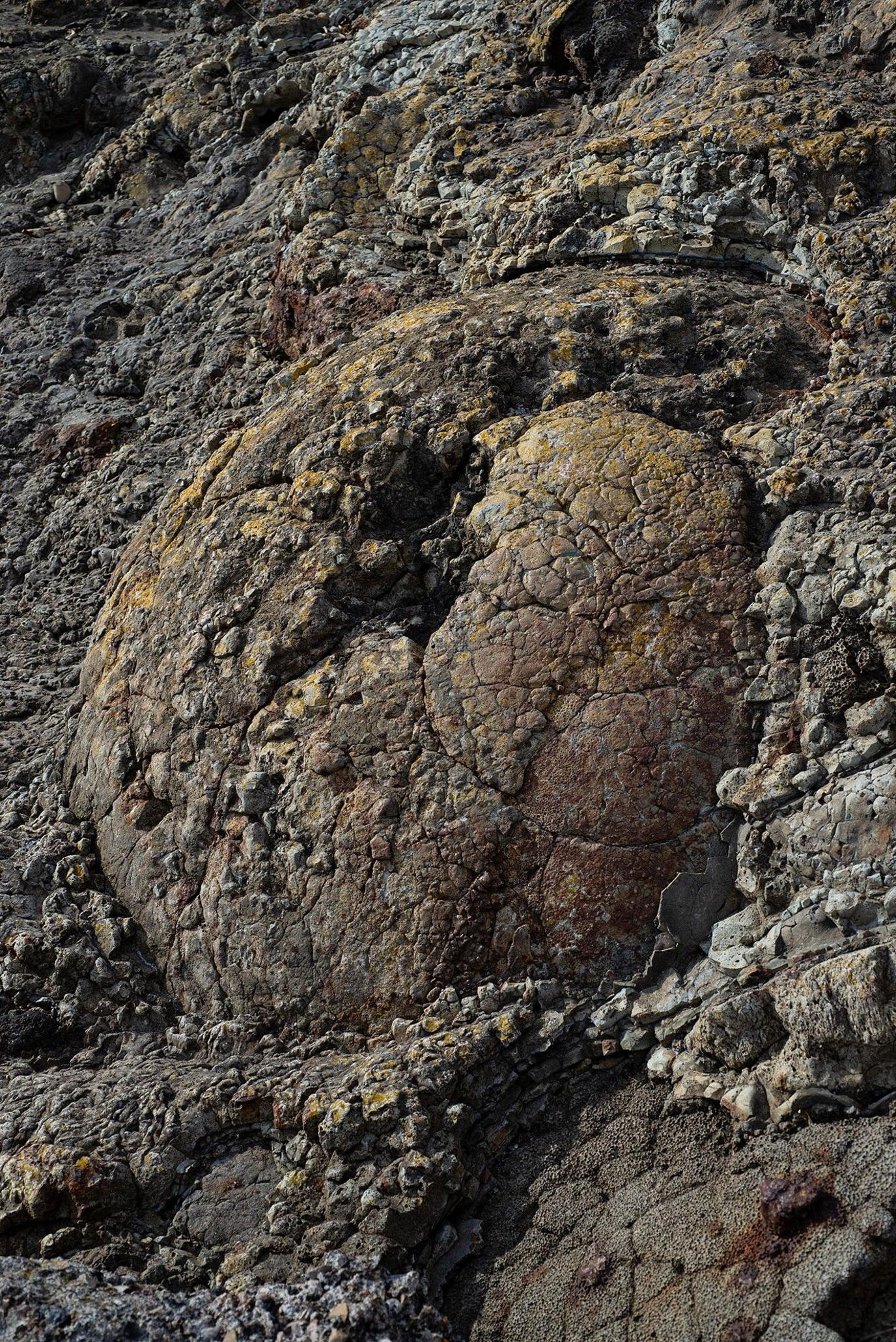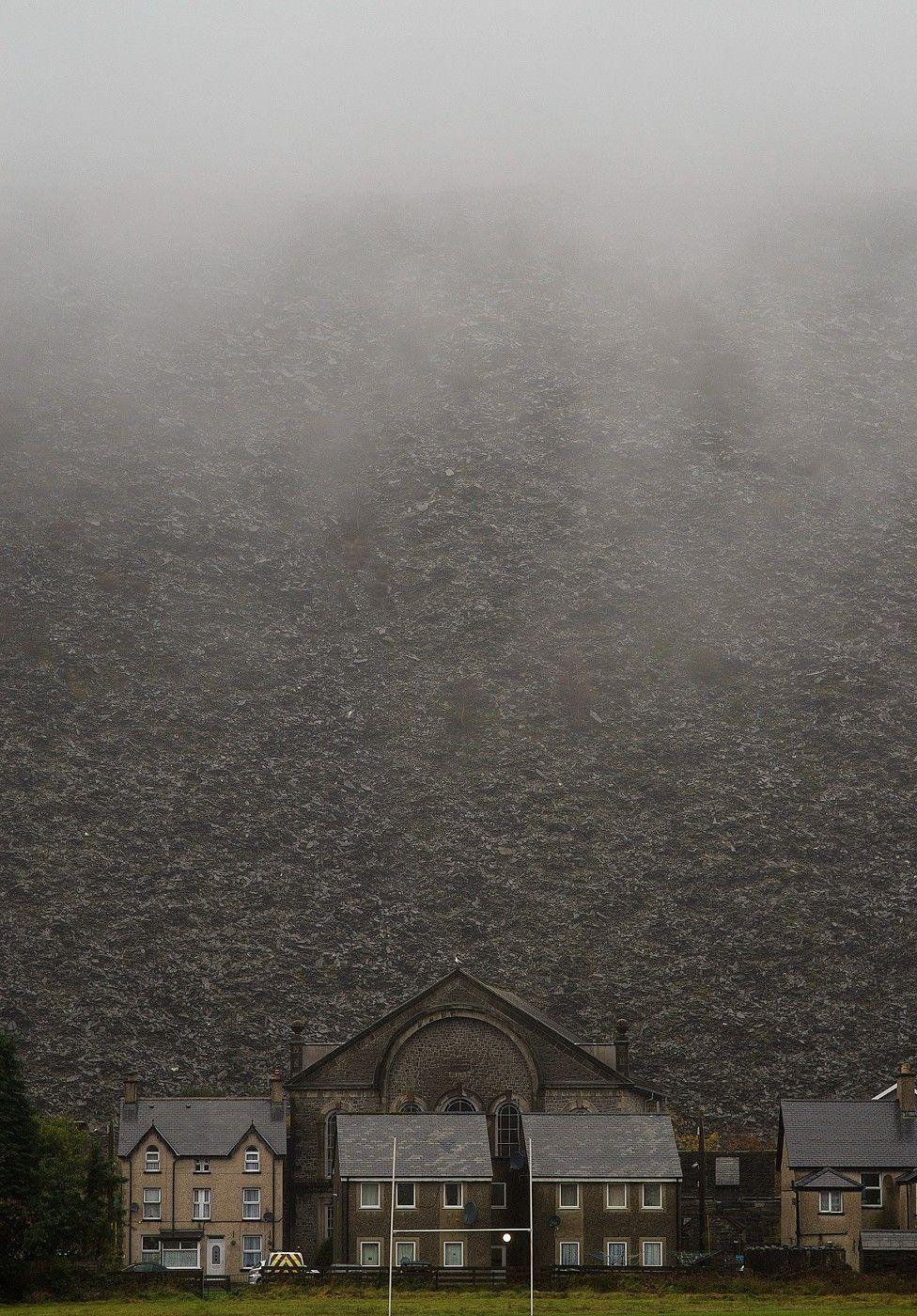Art capturing a disappearing industrial landscape

The landscape described as Finger Tips by Jon Pountney, former spoil tips at Clwyd y Fagwyr, Merthyr Tydfil
- Published
Is Wales’ once-proud industrial history being left to quietly disappear into the arms of nature and decay?
For artist Jon Pountney, who has spent the past decade documenting the remains of Welsh industrial history, the question is a pertinent one.
He made his home in Wales after arriving in Cardiff to study photography at university in the 1990s and, although a long-time resident, said: “I’m always keen to say that I’m looking from a non-native point of view.
“History has always interested me and recent history – in the grand scheme of things, these ruins are fairly recent.”

An impression of a "skull" in a slag heap on the Splott foreshore in Cardiff, where the idea for the project began
The idea for the focus on industry first surfaced closed to his then-home in Cardiff, on the Splott foreshore area, as he was working on a project which was later shown at Oriel Colwyn in north Wales.
He said: “It’s a very interesting space. It’s not a sandy beach. It’s made up of brick rubble which is from the steelworks in East Moors, which was across the way from where the beach is, and so-called slum clearance in the southern streets of Splott in the late 1970s.
“So the beach is made up of this industrial detritus really which has just been pushed out into the water and left. From a distance it’s kind of picturesque but when you come down to look at it in close examination, it’s all brick and rubble.”

Penwyllt quarry in the Swansea Valley section of Bannau Brycheiniog National Park used to produce limestone until the 1950s
He has captured images from all over south Wales in particular and mid Wales as he started exploring beyond Cardiff, beginning with the valleys, near where he now lives in Treforest, Rhondda Cynon Taf.
“I’d see these amazing sights that are everywhere in the valleys. They’re hidden in plain sight because there’s so many.
“What’s struck me throughout doing this project is so many of these spaces aren’t protected or loved or used,” he said.
“A huge part of this project is a warning to the future that these post-industrial spaces of the past are our industrial spaces of the present now. If you look at somewhere like Port Talbot – what will Port Talbot steelworks look like in 100 years?

Port Talbot steelworks in its current form is under threat, with almost 2,000 jobs at risk
“I was thinking about the poem Ozymandias where there’s a statue looking out on a wasteland. Once upon a time it was a godlike Pharoah figure looking out on a civilisation but now it’s just a desert.
“There’s quite a few statues up the valleys of coal and iron magnates and they’re now looking out on nothing or an industrial estate. What was their works or coal mine is gone and it’s been replaced by just a load of sheds in some places.”
A number of Welsh industrialists were at one time some of the richest people in the world, although little remains of their domain now, and he wonders if a similar fate awaits today's financial giants.
“To think of the way these spaces were managed, way those spaces were managed and the riches they created, did that ever feed back into Wales as a society and again that’s a story for today.
“People working in Port Talbot are on good wages, but all the money that site must have made in the past or could still make maybe with government ownership, it’s where do the profits go, and that’s the subtext to the project really.
“Aesthetically it’s about these spaces but the subtext is what can we learn for the future.”

The former Dunlop rubber works boiler house in Brynmawr

Cwmystwyth in Ceredigion had metal mines dating back to the Bronze Age
One place which has stayed with Jon is Cwmystwyth in Ceredigion, near Aberystwyth.
He explains: “It’s a valley which is an ancient gold, lead and copper mine where I think one of the oldest manmade golden objects in Wales was found not that long ago.
“Wow, what a landscape. If it was anywhere else in the world it would have a visitor centre and boards telling you this view was this, but obviously in Wales we only do castles.
“The landscape itself, where all the mineral ore has washed out of the hillsides, greens, oranges, just incredible colours, and I managed to get there just at a time when the light was changing quite quickly with wind and cloud and it just looked really amazing.
“It made me think I’ve got to continue this project.”

Penallta colliery building is now a bookend to a housing estate built over the old pit site

Jon Pountney, pictured, focuses on industrial remains but the natural world around it often forms an important part of the composition
“I think nature is doing an immense amount to just obliterate a lot of this history and I think it’s incredible the speed with which some of the stuff happens.
He described a meeting with a former miner who talked of the “hellscape” of spoil tips and a devastated landscape in the time of the pits, who had questioned who would want to live in such a place.
But now “60 years on or whatever, he said ‘it’s me. I’m here now. There’s birds of prey, it’s quiet, you can hear running water’.
“That really fascinated me because I can’t imagine how awful that landscape did look.
“They [the industrial remains] almost look like follies or have almost been made picturesque by nature and that obviously is part of the idea of the project. It is strange to see how quickly trees and shrubs and stuff can obliterate stone walling.”
Artist's 10-year mission to paint everyone in UK's smallest city
- Published24 September 2023
How art helps shine new light on colonial history
- Published26 November 2023

Capel Rhiw underneath the slate mountains in Blaenau Ffestiniog - this image is currently on display in the National Library
Jon is now planning to expand the project further into north Wales after receiving a commission to work in the Blaenau Ffestiniog area with young people, reflecting on the landscape.
He will also work on documenting Port Talbot steelworks for an academic project looking at how the end of work in an area impacts local people.
"Port Talbot is the last bastion of this kind of dying breed unfortunately, and beyond that, what's left?" he asks.
"Not very much unfortunately."

Drone photography of Aberavon beach with Port Talbot steelworks - is this a future industrial ruin?